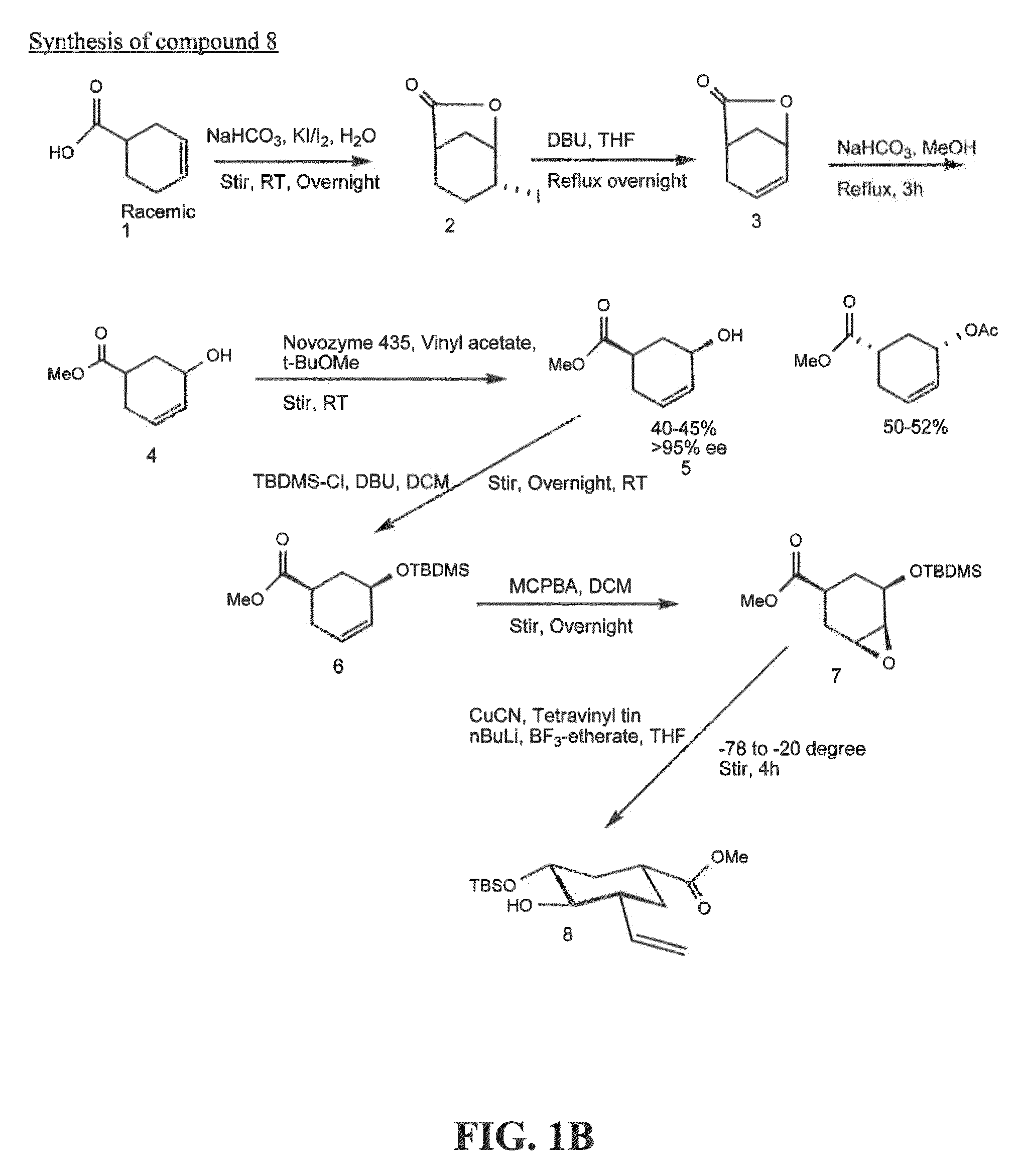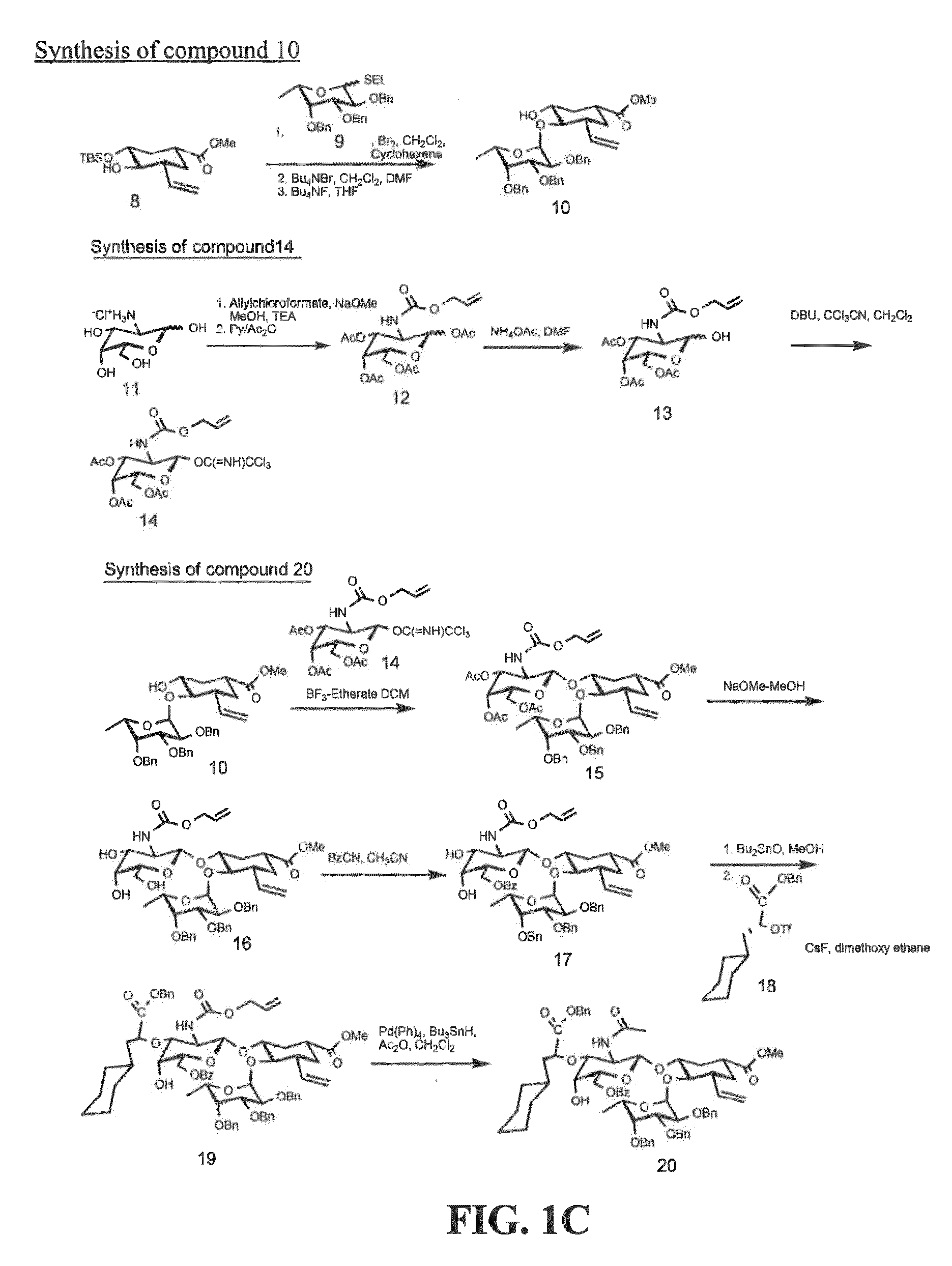E-selectin antagonist compounds, compositions, and methods of use
a technology of e-selectin and antagonists, applied in the field of e-selectin antagonists, can solve the problems of venous thromboembolism (vte), affecting the survival rate of patients, so as to decrease and reduce the likelihood of occurrence of infiltration
- Summary
- Abstract
- Description
- Claims
- Application Information
AI Technical Summary
Benefits of technology
Problems solved by technology
Method used
Image
Examples
example 1
Synthesis of E-Selectin Inhibitor
[0201]Exemplary glycomimetic compounds of formula I were synthesized as described in this Example and as shown in the exemplary synthesis schemes set forth in FIGS. 1-2.
Synthesis of Compound 2
[0202]Compound 1 (60 g) was suspended in H2O (800 ml) and cooled to 0° C. Solid NaHCO3 (120 g) was added in portion with stirring and then a solution of KI (474.3 g) and I2 (127 g) in H2O (800 ml) was added with stirring. Reaction mixture was stirred at room temperature overnight in the dark. Reaction mixture was then extracted with CH2Cl2 (3×500 ml). The organic layer was washed with Na2S2O3 solution (2×500 ml) and then the combined aqueous layers were extracted with CH2Cl2 (2×300 ml). Organic layers (2100 ml) were combined and washed with cold H2O (1×500 ml) and cold brine (1×500 mil). The organic layer was dried over Na2SO4, filtered, and concentrated to dryness to give compound 2 as light yellow crystals (119 g). Purity: >95% by TLC.
Synthesis of Compound 3
[0...
example 2
E-Selectin Activity
Binding Assay
[0236]The inhibition assay to screen for and characterize glycomimetic antagonists of E-selectin is a competitive binding assay, which allows the determination of IC50 values. E-selectin / Ig chimera was immobilized in 96 well microtiter plates by incubation at 37° C. for 2 hours. To reduce nonspecific binding, bovine serum albumin was added to each well and incubated at room temperature for 2 hours. The plate was washed and serial dilutions of the test compounds were added to the wells in the presence of conjugates of biotinylated, sLea polyacrylamide with streptavidin / horseradish peroxidase and incubated for 2 hours at room temperature.
[0237]To determine the amount of sLea bound to immobilized E-selectin after washing, the peroxidase substrate, 3,3′,5,5′ tetramethylbenzidine (TMB) was added. After 3 minutes, the enzyme reaction was stopped by the addition of H3PO4, and the absorbance of light at a wavelength of 450 nm was determined. The concentration...
example 3
Effects of Treatment with an E-Selectin
Specific Antagonist (Compound 25) in a Leukemia Animal Model
[0241]The E-selectin ligand HCELL (hematopoietic cell E- / L-selectin ligand) is expressed by normal hematopoietic stem cells (Merzaban et al., Blood 118(7):1774-83 (2011)) as a functional glycoform of CD44. High level CD44 expression (99%±1.4%) has also been observed by blasts from 55 patients with acute myeloid leukemia (AML) (i.e., AML blasts) and by putative CD34+CD38−CD123+ leukemia stem cells (LSCs) (99.8%±0.6%). The mean fluorescence intensity (MFI) for CD44 expression by AML blasts was one to two logs higher than the MFI for 16 other adhesion receptors. The majority of blasts from patients with AML also express an E-selectin ligand by flow cytometry: >75%% of 22 primary gated blast samples exhibit ≧10% binding of E selectin-IgG chimeric protein with a mean of 22.7%±0.17% SD, range 1.8 to 66.2%. The ligand was identified as HCELL by immunoprecipitation of CD44 from AML cell membra...
PUM
| Property | Measurement | Unit |
|---|---|---|
| temperature | aaaaa | aaaaa |
| temperature | aaaaa | aaaaa |
| temperature | aaaaa | aaaaa |
Abstract
Description
Claims
Application Information
 Login to View More
Login to View More - R&D
- Intellectual Property
- Life Sciences
- Materials
- Tech Scout
- Unparalleled Data Quality
- Higher Quality Content
- 60% Fewer Hallucinations
Browse by: Latest US Patents, China's latest patents, Technical Efficacy Thesaurus, Application Domain, Technology Topic, Popular Technical Reports.
© 2025 PatSnap. All rights reserved.Legal|Privacy policy|Modern Slavery Act Transparency Statement|Sitemap|About US| Contact US: help@patsnap.com



